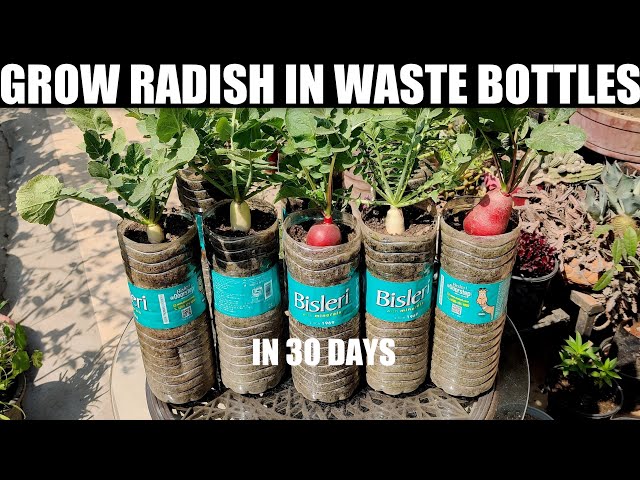Growing radishes in waste bottles is a great way to reuse materials and produce fresh, homegrown vegetables. This method is often referred to as “container gardening” and is suitable for small spaces, including balconies or windowsills. Here’s a step-by-step guide on how to grow radishes from seeds to harvest in waste bottles:
Materials Needed:
- Clean, empty plastic bottles with caps (e.g., soda bottles, milk jugs)
- Potting soil or a well-draining growing medium
- Radish seeds
- Scissors or a utility knife
- A marker or pen
- Watering can or spray bottle
Steps:
- Prepare the Bottles:
- Choose your empty plastic bottles and ensure they are clean and free of any residues. Remove labels and caps. You can use various sizes of bottles based on your available space.
- Cut the Bottles:
- Use scissors or a utility knife to carefully cut the bottle in half, approximately at the point where the top half starts to curve down towards the bottom. The bottom half will serve as the pot for growing radishes, while the top half can be used as a lid to create a mini greenhouse effect.
- Poke Holes in the Bottom:
- In the bottom half of the bottle, poke or drill small drainage holes to ensure excess water can escape. Adequate drainage is essential to prevent waterlogged soil.
- Fill with Soil:
- Fill the bottom half of the bottle (the pot) with potting soil or a well-draining growing medium, leaving about an inch of space at the top.
- Sow Radish Seeds:
- Plant radish seeds in the soil according to the recommended spacing for the specific radish variety. Plant them at the depth specified on the seed packet.
- Water and Close the Lid:
- Water the soil thoroughly but gently to avoid displacing the seeds. Place the top half of the bottle (the lid) back on to create a mini greenhouse. This helps maintain humidity and creates a favorable microclimate for germination.
- Provide Light:
- Place your bottle radish garden in a location with ample sunlight. Radishes need at least 6 hours of direct sunlight daily.
- Watering:
- Keep the soil consistently moist but not waterlogged. You can use a spray bottle to mist the soil if needed. Ensure the lid remains on to help maintain humidity.
- Thin the Seedlings:
- As the radish seedlings grow, thin them out to ensure proper spacing. You can usually start thinning when they have at least two true leaves.
- Care and Maintenance:
- Continue to water and monitor the radish plants. Fertilize with a balanced, diluted liquid fertilizer according to the package instructions, usually once every couple of weeks.
- Harvest:
- Radishes are typically ready to harvest in about 3-4 weeks. Pull them up gently when they reach the desired size, which varies depending on the radish variety.
By growing radishes in waste bottles, you can enjoy fresh, homegrown produce while upcycling materials. This method is especially useful for quick-growing vegetables like radishes, and it’s an excellent option for those with limited garden space.
GROWING TIPS:- Sowing Season -Spring and Winter months ( Ideal temperature 8-28 degree Celsius) AUGUST MID TO JANUARY MID Radish germinates in about 5 days and is ready for harvest in 4-5 weeks. Soil Type and Prep – well-drained soil rich in organic matter such as compost or composted manure(40% GARDEN SOIL+ 30% COMPOST+30% RIVER SAND/COCOPEAT/PERLITE) Instead of sowing radish seeds in seed trays, plant them directly in the desired pots. Germination Temperature : 8°C – 28°C. Sunlight – Sun to partial shade. Water – Water whenever soil feels dry to touch.


